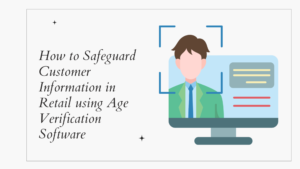
Age verification software allows organizations and enterprises to determine the age of its consumers. This is frequently done as part of the onboarding or KYC (Know Your Customer) procedure.
There are several types of age verification software. It can be part of a whole identity verification solution, with an Application Programming Interface (API) for integration with other corporate systems. Or, it might be a dedicated tool that only accomplishes the task, and works in conjunction with other tools.
There are also digital products specialized to age verification, and offline field solutions, such as smartphone apps that validate IDs at casinos and music festivals.
The means of age verification can vary just as much as its uses. Some systems emphasize on document verification and database checks, such as those from governments and credit reference bureaus. Others include video calls and live agent encounters.
This article explores how to safeguard customer information in retail using age verification software. But, first, let’s find out what age verification software is.
What is Age Verification Software?
Age verification is a form of identity verification solution. It is the process of checking someone’s age to make sure they are old enough to access material or services that are only for people of a certain age.
Age verification is usually used in situations where people under a certain age can’t see or use certain content or services, such as those linked to alcohol, tobacco, or adult material.
To check a person’s age, personal details like their name, date of birth, or government-issued identification code may be essential. The person’s age is then confirmed by comparing this information to known data sources.
Age verification is important because it keeps minors from getting access to certain material or services that could be dangerous or inappropriate for them. This check is also required by law in many countries for certain kinds of content or services that are age-restricted.
An age verification system may assist you to make a website that is compliant and has automatic digital identity features so that users can feel safe and have a smooth experience.
How Does the Age Verification System Work?
The flexible and secure age verification system helps in verifying age within any business system. It uses several methods to figure out how old an individual is. Age verification, like most KYC checks, usually involves looking at official documents like passports, driver’s licenses, and other types of government ID.
Along with their date of birth, customers send in these papers (scanned documents and photos are often accepted). Sometimes, a digital process requires the user to share a selfie picture or video along with their documents.
Most of the time, the checks are done automatically with the help of government systems or credit files. In some cases, systems send all or some of these checks to people for review by hand.
Age Verification Software in Retail Sector
Age verification software is critical in the retail sector for assuring the security of customers’ information. It operates by applying numerous methods to verify clients’ ages, especially when age limits apply, such as;
- When purchasing age-restricted products
- Accessing age-restricted content.
Businesses may assure compliance with legal requirements, prevent minors from obtaining age-restricted products, and protect customer information by confirming client age.
Here’s an in-depth look into how age verification software safeguards customer information in retail:
Accurate Identification and Authentication
Age verification software uses a variety of approaches to verify consumers’ identities and ages. This might include using optical character recognition (OCR) technology to scan government-issued IDs like driver’s licenses or passports.
To improve accuracy and avoid fraud, certain software systems include biometric verification, such as facial recognition or fingerprint scanning.
Real-Time Collection of Data
When an individual’s ID is scanned or biometric data collected, the age verification software rapidly processes the information to ascertain the customer’s age.
It compares the data to a comprehensive database of age-related information to determine whether the consumer is of legal age for a given product or service. This real-time verification procedure ensures that age assessments are swift and precise.
Compliance to Authority
Age verification software can be incorporated into a retailer’s current processes and systems. You can have it integrated into POS terminals, self-checkout kiosks, or internet platforms to speed up the age verification process. Retailers can assure consistent compliance to secure customer data and reduce the chance of human error by automating the verification steps.
Applies Industry’s Best Practices
To ensure the highest level of data safety, trustworthy software suppliers follow industry best practices and comply with privacy requirements such as the General Data safety Regulation (GDPR) or the California Consumer Privacy Act (CCPA).
Age verification software applies strong data security procedures to protect consumer information. Encryption techniques are used to secure sensitive data during transmission and storage.
Businesses can improve customer trust, prevent unlawful access to age-restricted products, and greatly minimize the risks associated with data breaches by deploying age verification software in the retail setting.
Key Takeaways
Age verification software is a significant tool for merchants wishing to protect consumer information effectively, thanks to its trustworthy identification and authentication procedures, real-time verification capabilities, easy integration, and strong data security measures.
Protecting consumer information in the retail industry is critical to preserve trust, protect confidentiality, and comply with legal requirements. Using age verification software to ensure the security and integrity of sensitive data is indeed an effective approach.
Retailers can reap numerous benefits from deploying this technology, including increased customer confidence, a decreased likelihood of fraud and identity theft, and adherence to regulatory standards.
The identity verification software offers a dependable way to confirm consumers’ age-related information while protecting their privacy. It lets retailers to rapidly and precisely check consumer age, ensuring that age-restricted items or services are only accessed by those of legal age. This not only safeguards vulnerable individuals, but also protects retailers from the ramifications of noncompliance.
